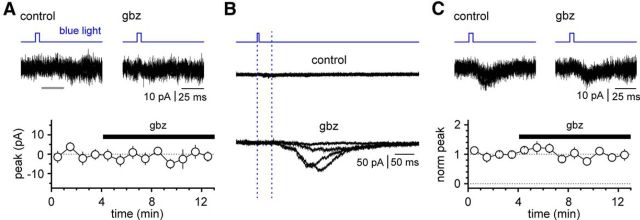Figure 11.
Effects of suppressing fast GABAergic inhibition on light-evoked responses in pyramidal cells. A, Top, Traces from a nonresponsive pyramidal cell in control conditions and in the presence of gabazine (gbz; 12.5 μm). Notice that gabazine application does not reveal latent polysynaptic pathway. The gray line shows the time window used to measure the peak current following the light flash. Four sweeps were superimposed in both condition. Bottom, Summary plot from 9 of 10 pyramidal neurons that did not produce light-evoked currents either in the control condition or after the addition of gabazine (empty circles, mean; bars, SE). B, Sweeps from the single experiment where gabazine application unmasked latent polysynaptic pathways. Top, Four traces superimposed in control conditions. Bottom, Four records in the presence of gabazine. Notice the long latency from the beginning of the light flash (dotted blue lines for reference), which is incompatible with the much shorter latencies usually recorded in light-responsive pyramidal cells (compare Fig. 7). C, Top, Light-evoked responses in pyramidal cells in control conditions and after the addition of gabazine. Four sweeps were superimposed in both condition. Notice that responses are unchanged by the addition of the drug. Bottom, Summary graph for all the responsive cells tested (norm peak, normalized peak of the synaptic response; empty circles and bars, mean and SE, respectively). The mice used for these experiments (n = 3) were selected at a postnatal stage associated with GABAA receptor-mediated inhibition in hippocampal pyramidal neurons (P15, P17, and P18; see Banke and McBain, 2006).

